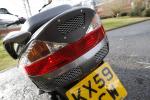Hydrogen Fuel Cell
By Kevin Ash - 21/03/2011
There are two basic types of electric vehicle, those powered by batteries and those which use fuel cells.
Batteries are heavy, use lots of space, give a limited range and take a long time to charge, so they‘re hardly ideal unless technology manages to improve these problems soon. Fuel cells are more appealing because refuelling takes only a matter of minutes (not much longer than refuelling a bike with petrol) and they‘re considerably lighter and more compact. The main problems at the moment are generating sufficient power and their bulk compared with conventional engines, but both have improved to the point where fuel cell bikes are becoming viable, as Suzuki‘s Burgman prototype demonstrates.
Suzuki Hydrogen Fuel Cell Scooter Feature here

A fuel cell needs a constant supply of hydrogen (although some work with other fuels), which it gets from a tank on board the bike, and oxygen, which comes from the air. Inside the cell are an anode and a cathode in two zones separated by a Polymer Electrolyte Membrane (PEM). When hydrogen gas flows across the anode, a platinum catalyst separates the atoms into their constituent protons and electrons. The electrons flow into the anode, around the electrical circuit which powers the electric motor driving the bike, and back to the cathode. The hydrogen‘s protons meanwhile, called positive ions, flow through the PEM to the cathode, where they combine with oxygen and the electrons, forming water. This is the fuel cell‘s waste product, which is a lot less difficult to deal with than the carbon dioxide, hydrocarbons and oxides of nitrogen produced by a petrol engine.

A single fuel cell produces little more than 0.5V, so lots of small ones are stacked together in series to increase the voltage. Stacking further banks of cells in parallel ups the current available.
Although the only waste product is water, this does not qualify fuel cell vehicles as being green, despite the many claims that this is so, as the hydrogen fuel has to be produced by a process that demands electricity. While this comes from gas, coal and oil fired power stations, as 74 per cent of the UK‘s does, all a fuel cell is doing is moving the polluting process from one place to another. The only fully green solution would be to use either renewable energy such as wind or tides, all of which are disappointing to date, or nuclear energy, which has its own waste disposal issues.

A problem with some hydrogen-fuelled vehicles is storing the hydrogen as a liquid. To do this it must be kept in a pressurised cryogenic tank, as it boils at atmospheric pressure at anything above -253 degrees C. These tanks are bulky and heavy, although not impossibly so for motorcycle use. Also, if you leave the bike for any length of time it must be plugged in to a power source to keep the tank refrigerated.
On the Burgman the hydrogen is stored as a gas under pressure, which means it‘s able to carry less (around 1.1lb / 0.5kg of hydrogen) but the storage issues are simpler to deal with. There‘s no way though to prevent the hydrogen leaking, even through a steel tank‘s walls.
Donate to the Kevin Ash Fund
Kevin's funeral was held on Thursday 28th February 2013 and was well attended by family, friends and colleagues.
The Telegraph has very kindly established The Telegraph Kevin Ash Fund to assist with the education of Kevin's three daughters.
If you'd like to make a donation then you can use the PayPal 'Donate' button below which will allow you to donate from your PayPal account, or via credit or debit card. A small percentage (about 3.4%) will be retained by PayPal for the service.
Kevin's family have been touched by the generosity and messages of support from people using the website and would like to express their gratitude to those who have contributed in any way.
The donations keep coming in, thank you so much, and the family especially like it when you leave a message.
Home | ![]() facebook.com/KevinAshFund
|
facebook.com/KevinAshFund
| ![]() twitter.com/KevinAshFund | © 2011
twitter.com/KevinAshFund | © 2011